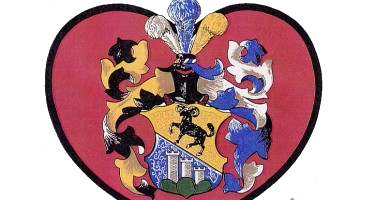 The story of Stettler, is not much different than any other town. However it is a story about a town, that has been commented on by many
over the years, as an impressive location.
The story of Stettler, is not much different than any other town. However it is a story about a town, that has been commented on by many
over the years, as an impressive location.
The Stettler area, was already rich in Canadian history. Just a few miles to the west, was the former site of Tail Creek.
A temporary hunting community, that during the hunting season, attracted enough people looking ot hunt the buffalo, that it was regarded as the largest
settlement west of Manitoba. An impressive feat for just the few months out of the year, that most people would reside in temporary huts, and cabins in the area. However, as
the buffalo began to vanish, Tail Creek began to disappear as well. Sergeant Sam Steele of the North West Mounted Police, would venture through the Buffalo Lake region, on the
lookout for whiskey traders, and other roaming criminals that the western prairies were known for. The Canadian government, was moving west, and the rail road was moving more and more people to the rather unexplored areas every day.
 In the early 1900's, a Swiss immigrant by the name of Carl Stettler, moved to the area, in hopes of establishing a Swiss/German Colony in the untouched reaches of the territory. Stettler, who had come to Canada, after several years in America, where he lived in mostly Swiss/German settlements, and already ran several successful business ventures.
Stettler had already been in talks with the Canadian Pacific offices in Eastern Canada, and they refered him to their land agent company in Calgary. The company was called the Calgary Colonization Company, and had already been involved in several successful land sales in southern Alberta. One of the heads of the company, had established an agent's office in High River, and managed to sell sixty-thousand acres of CPR land in quarter section incriments (160acres).
Carl's
In the early 1900's, a Swiss immigrant by the name of Carl Stettler, moved to the area, in hopes of establishing a Swiss/German Colony in the untouched reaches of the territory. Stettler, who had come to Canada, after several years in America, where he lived in mostly Swiss/German settlements, and already ran several successful business ventures.
Stettler had already been in talks with the Canadian Pacific offices in Eastern Canada, and they refered him to their land agent company in Calgary. The company was called the Calgary Colonization Company, and had already been involved in several successful land sales in southern Alberta. One of the heads of the company, had established an agent's office in High River, and managed to sell sixty-thousand acres of CPR land in quarter section incriments (160acres).
Carl's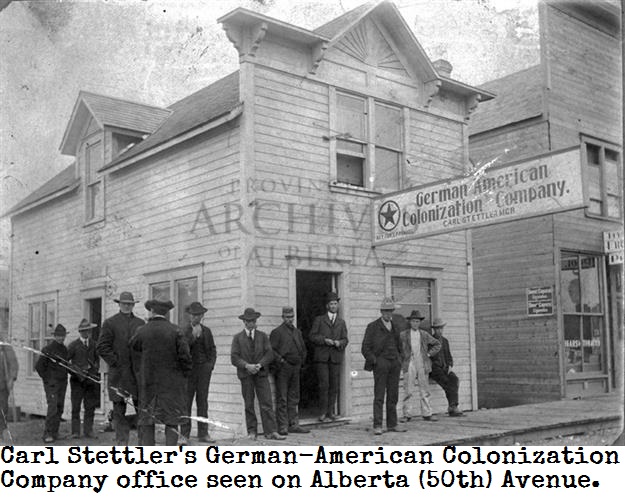 contact at the company, managed to partner him up with 2 men who owned and operated the German Colonization Company. Both groups were looking to establish a German settlement at the end of CP's proposed spur out of Blackfalds, towards the west. Stettler was a perfect fit for the German American Colonization company. He was eager to establish the new community himself,
and this would allow his associates to remain in Calgary, and continue their operations in that area. Although the free homestead land the Canadian Government was offering, was out of any real control of Stettler, and his associates, they would work together, to put as many German settlers in that block as they could. After the homestead land was filled, they could begin selling the CP land, which gave them more opportunity to make money. contact at the company, managed to partner him up with 2 men who owned and operated the German Colonization Company. Both groups were looking to establish a German settlement at the end of CP's proposed spur out of Blackfalds, towards the west. Stettler was a perfect fit for the German American Colonization company. He was eager to establish the new community himself,
and this would allow his associates to remain in Calgary, and continue their operations in that area. Although the free homestead land the Canadian Government was offering, was out of any real control of Stettler, and his associates, they would work together, to put as many German settlers in that block as they could. After the homestead land was filled, they could begin selling the CP land, which gave them more opportunity to make money.
The location of the proposed terminus, was to be kept a secret, until the CP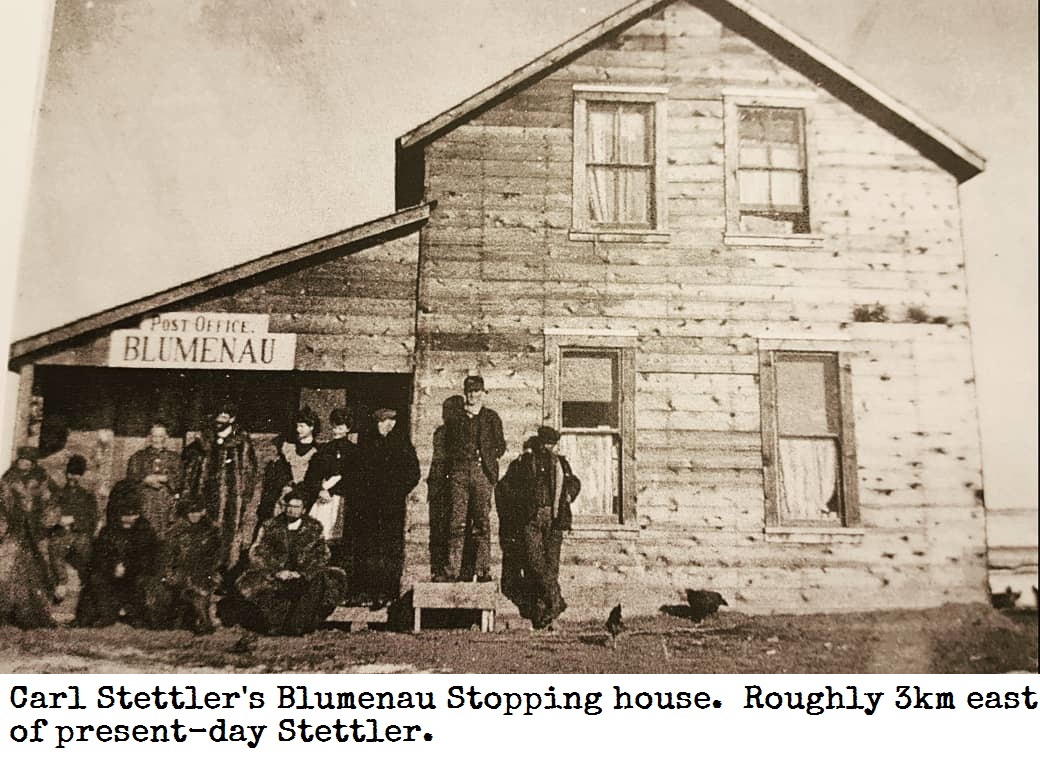 was in a position to sell the land in the area. So to sort of supervise the sales and settlement of the area, Carl and his family, established a stopping house a few miles from the proposed location. From here, they could work with settlers coming to the area prior to the arrival of the train, and have a bit better idea on how to make the proposed terminus work in their favor.
In the summer of 1903, Carl, his step-son George Raemer, and a handful of Swiss settlers from Wisconsin, came west to settle near the proposed townsite, which only Stettler, and the CP surveyor in the region knew the location of. Although the area had been surveyed, and staked in 1894, by 1903, the areas south of the correction line had not been surveyed, and was not eligible for homesteading. Surveyors arrived in 1904 under the federal government's orders, in order to begin the homesteading process in the area. In the spring of 1904,
Stettler had lumber and other supplies carted in from Blackfalds, in order to build a stopping house. He would name the stopping house Blumenau. In 1905, supplies for the construction of the local office of the German American Colonization Company was freighted in (most likely from Alix). This building would also serve as the area's post office. A grocery store was also built in 1905. was in a position to sell the land in the area. So to sort of supervise the sales and settlement of the area, Carl and his family, established a stopping house a few miles from the proposed location. From here, they could work with settlers coming to the area prior to the arrival of the train, and have a bit better idea on how to make the proposed terminus work in their favor.
In the summer of 1903, Carl, his step-son George Raemer, and a handful of Swiss settlers from Wisconsin, came west to settle near the proposed townsite, which only Stettler, and the CP surveyor in the region knew the location of. Although the area had been surveyed, and staked in 1894, by 1903, the areas south of the correction line had not been surveyed, and was not eligible for homesteading. Surveyors arrived in 1904 under the federal government's orders, in order to begin the homesteading process in the area. In the spring of 1904,
Stettler had lumber and other supplies carted in from Blackfalds, in order to build a stopping house. He would name the stopping house Blumenau. In 1905, supplies for the construction of the local office of the German American Colonization Company was freighted in (most likely from Alix). This building would also serve as the area's post office. A grocery store was also built in 1905.
Although Carl Stettler's early settlement plan, had been to encircle the future townsite, there had been a few hitches in the process. The largest of which, was several changes to the route the new CP line was to take. Canadian Pacific, had decided to change their plans to bring the spur from Blackfalds, and would instead bring it from Lacombe. Strangely enough, the proposed Blackfalds route, would later be used by the Canadian Northern (now Canadian National) Rail Road, and although Stettler was not it's planned destination, the route would come into the community of Stettler eventually.
This origin change would however present several small problems with the spur's routing. The end result of CP's change in origin, which caused problems for the construction crews along the way, and required several route changes of its own, was that the terminus would not be where they had originally planned. Carl Stettler had built the German American Colonization Company/Post office building, believing he would only have to move it roughly a mile when the townsite was officially announced. However the new terminus site would require the existing structure be moved three miles. A rather large inconvenience, especially at that time.
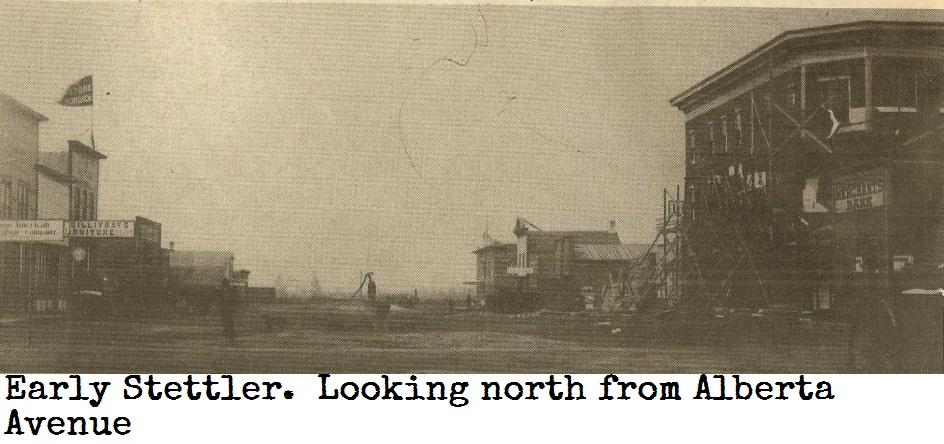
In the summer of 1905, the CP construction crews, were nearing the new townsite, and a fledgling community, began to take shape. Things moved rapidly from that point. The rest of Carl's family, came from their rented home in Blackfalds, to the stopping house known as Blumenau, and Carl, who was given first pick on lots in the CP's new terminus, picked a large commercial lot to begin building a hotel. Shortly after CP released control of the townsite to their agents, Wilson Pyper arrived, and quickly began building the Dominion hotel on the lots he had purchased very early on. The first true freight train, arrived on November 16th. Freight on the train
included tools for George Farmer who would be one of the town's first councillors, and whose home still stands just off Main Street. There was also lumber for F.T Colley, who would later have a country school named after him, and was a successful builder in town. Furniture for N.B. McGillivary was also on the train. McGillivray would become the town of Stettler's first Mayor a short time later, and sat on many of the early boards that were formed.
In 1906, Stettler was established as a village in the new province of Alberta. Mr. G.C Bentley was appointed as overseer. In November of 1906. Less than a year since the first shack went up on the townsite, Stettler had a population of 700, with almost 70 businesses, the newly created village, was incorporated as the Town of Stettler.
Stettler's first town council was governed by Mr. N.B. McGillivary(mayor) with Mr. W.B. Gray(town clerk) The rest of the council was comprised of Mr. Carl Stettler, Mr. J.N. Tice, Mr. W. Dunlap, Mr. J.P Grigg, Mr. N. Burdick, and Mr. G.R. Farmer. Many of these councillors' names would appear on the earliest businesses up and down Main Street.
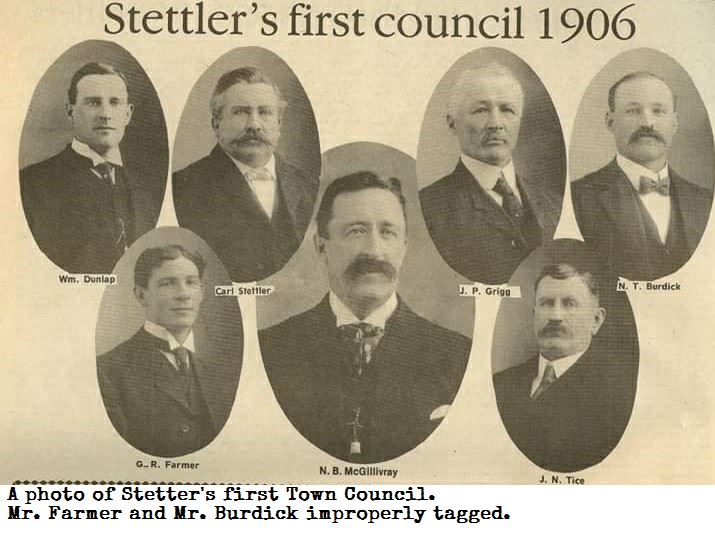
|


 contact at the company, managed to partner him up with 2 men who owned and operated the German Colonization Company. Both groups were looking to establish a German settlement at the end of CP's proposed spur out of Blackfalds, towards the west. Stettler was a perfect fit for the German American Colonization company. He was eager to establish the new community himself,
and this would allow his associates to remain in Calgary, and continue their operations in that area. Although the free homestead land the Canadian Government was offering, was out of any real control of Stettler, and his associates, they would work together, to put as many German settlers in that block as they could. After the homestead land was filled, they could begin selling the CP land, which gave them more opportunity to make money.
contact at the company, managed to partner him up with 2 men who owned and operated the German Colonization Company. Both groups were looking to establish a German settlement at the end of CP's proposed spur out of Blackfalds, towards the west. Stettler was a perfect fit for the German American Colonization company. He was eager to establish the new community himself,
and this would allow his associates to remain in Calgary, and continue their operations in that area. Although the free homestead land the Canadian Government was offering, was out of any real control of Stettler, and his associates, they would work together, to put as many German settlers in that block as they could. After the homestead land was filled, they could begin selling the CP land, which gave them more opportunity to make money. was in a position to sell the land in the area. So to sort of supervise the sales and settlement of the area, Carl and his family, established a stopping house a few miles from the proposed location. From here, they could work with settlers coming to the area prior to the arrival of the train, and have a bit better idea on how to make the proposed terminus work in their favor.
In the summer of 1903, Carl, his step-son George Raemer, and a handful of Swiss settlers from Wisconsin, came west to settle near the proposed townsite, which only Stettler, and the CP surveyor in the region knew the location of. Although the area had been surveyed, and staked in 1894, by 1903, the areas south of the correction line had not been surveyed, and was not eligible for homesteading. Surveyors arrived in 1904 under the federal government's orders, in order to begin the homesteading process in the area. In the spring of 1904,
Stettler had lumber and other supplies carted in from Blackfalds, in order to build a stopping house. He would name the stopping house Blumenau. In 1905, supplies for the construction of the local office of the German American Colonization Company was freighted in (most likely from Alix). This building would also serve as the area's post office. A grocery store was also built in 1905.
was in a position to sell the land in the area. So to sort of supervise the sales and settlement of the area, Carl and his family, established a stopping house a few miles from the proposed location. From here, they could work with settlers coming to the area prior to the arrival of the train, and have a bit better idea on how to make the proposed terminus work in their favor.
In the summer of 1903, Carl, his step-son George Raemer, and a handful of Swiss settlers from Wisconsin, came west to settle near the proposed townsite, which only Stettler, and the CP surveyor in the region knew the location of. Although the area had been surveyed, and staked in 1894, by 1903, the areas south of the correction line had not been surveyed, and was not eligible for homesteading. Surveyors arrived in 1904 under the federal government's orders, in order to begin the homesteading process in the area. In the spring of 1904,
Stettler had lumber and other supplies carted in from Blackfalds, in order to build a stopping house. He would name the stopping house Blumenau. In 1905, supplies for the construction of the local office of the German American Colonization Company was freighted in (most likely from Alix). This building would also serve as the area's post office. A grocery store was also built in 1905. 
